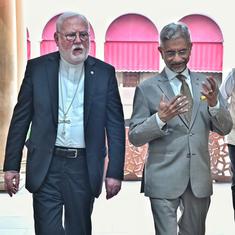People in the ruling party welcomed Antony’s “candour” and “harsh truths”. Senior BJP leader Lal Krishna Advani, the original crusader against Congress’ alleged minority appeasement, promptly welcomed Antony's “honest soul-searching”.
The BJP has accused the Congress of minority appeasement for as long as their rivalry has dominated national politics. Given their massive victory in the general election earlier this year and the Congress’ near decimation, we should not be surprised that minority appeasement has become conventional wisdom instead of a fringe theory.
But what exactly does minority appeasement mean? If we interpret it as responding to the needs of a community, then we must conclude that no such appeasement has taken place; the data is quite clear that on average, Muslims, who comprise India’s largest religious minority, suffer considerable deprivation.
In 2006, the Sachar Report reported that Muslims are poorer and have lower social indicators than Dalits. Muslim-dominated areas have fewer government services than average, such as public schools and banking services. Not having access to credit is a particular problem: the ratio of self-employed Muslims is higher than the national average.
Government-provided infrastructure, such as sanitation, lighting, water and roads, is also lacking in many areas Muslims live in. If Muslims are genuinely favoured under Congress rule, then why is that not showing up on any social and economic indicators?
The UPA seemed to be alert to this and made a fair bit of noise about uplifting Muslims. It designed a 15-point programme for minorities, which the BJP attacked bitterly as an exemplar of their appeasement policies. Yet, most of the points on this programme were not implemented.
The government made plans and allocated funds, but released very little money and spent even less. In 2012-13, for example, the government allocated Rs 100 crore to the Maulana Azad Education Foundation, but released just Rs 1 lakh.
In the same year, the government allotted Rs 18 crore to its Skill Development Initiative for Minorities, but released just Rs 4 lakh. Only 23% of the funds it allotted to its Minority Concentration Districts scheme, begun in 2007, had reached the districts by March 2011. So, areas with a high concentration of minorities continued to lag behind the national average.
In the year 2012-13, the minority affairs ministry spent a total of Rs 2,200 crore. To put that in perspective, the budget of the Sardar Patel Statue of Unity is Rs 2,500 crore.
Moreover, the plans were poorly designed, aimed more at achieving political impact than real results. For example, the previous, Congress-led government focused its efforts on modernising madrasas – a high-visibility target. Data, on the other hand, shows that less than 5% of Muslim students actually attend madrasas, preferring mainstream schools.
Not only has minority appeasement historically done little for the actual well-being of Muslims, the Congress-led government did not do much to change this in its two terms. All its talk of minority upliftment has been only that: talk.
Therefore, the minority appeasement to which Antony courageously admitted is actually just politically expedient tokenism. Not only does it do little for Muslim welfare, but by creating an atmosphere of perceived appeasement it ends up harming the community.
In 2013, in the Muzaffarnagar riots, for example, around 50 Muslims were killed and more than 50,000 displaced. But Hindutva groups said the violence was entirely the result of the ruling Samajwadi Party appeasing Muslims, making it sound as though victims had benefited from the rioting. Modi even gave a cabinet position to an accused in the violence, Sanjeev Baliyan.
Given this background, it is Indian Muslims who should celebrate the end of this brand of secular politics because this farcical tokenism harms more than it helps them.
But even as the Congress ostensibly moves away from appeasement, the BJP seems to be embracing it. In his first Lok Sabha speech, Modi talked of bringing in minority-specific programmes to target Muslim backwardness. This is a 180-degree shift for a party built on bitter opposition to appeasement.
The Gujarat government under Modi had in fact fought a legal battle to not implement the UPA’s minority scholarship scheme, claiming that by targeting a religious group it was discriminatory.
External affairs minister Sushma Swaraj attempted another policy somersault, promising to improve facilities for Haj pilgrims, a message that she delivered in high Urdu speaking at a Haj conference. This, after three decades of rallying against the Haj subsidy as the epitome of Congress’ Muslim appeasement.
Earlier, in the run-up to the general election, BJP party president Rajnath Singh was discovered praying at a dargah in full Muslim attire and he courted prominent clerics in a bid to win the Lucknow seat. Slowly, but surely, even the BJP seems to be realising the benefits of Muslim appeasement and so-called pseudo-secularism.
The fact is that tokenism towards Muslims has proved to be an effective and low-cost way to attract a large number of votes, as has been proven by a number of so-called secular parties. The BJP might have won a comfortable majority in terms of seats, but with only 31% of the popular vote, it has still some way to go to cement its dominance.
In power now, it might, therefore, have begun to view Congress-style Muslim appeasement as a good political strategy to achieve this.










